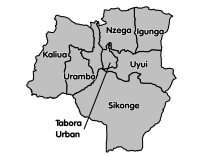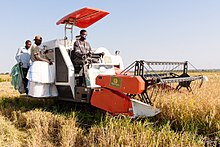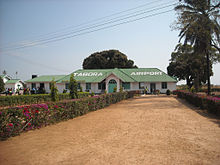Tabora (region)
| Tabora | |
|---|---|
| Basic data | |
| Country | Tanzania |
| Capital | Tabora |
| surface | 76,151 km² |
| Residents | 2,291,623 (2012) |
| density | 30 inhabitants per km² |
| ISO 3166-2 | TZ-24 |
Coordinates: 5 ° 0 ′ S , 33 ° 0 ′ E
The Tabora region is located in the western central highlands of Tanzania and has the capital of the same name, Tabora . The region borders the Shinyanga and Simiyu regions in the north, the Singida region in the east, the Mbeya region in the south, the Katavi region in the southwest and the Kigoma and Geita regions in the west .
geography
The region has 2,291,623 inhabitants (2012 census) and covers an area of 76,151 km² (roughly the size of Bavaria). The country lies at an altitude of 1000 to 1500 meters above sea level, in the north-west and south-east mountains rise to an altitude of up to 1800 meters. The southern and the western part of the country over the river Malagarasi in the Lake Tanganyika drained, the northeastern part of the drained river Manonga in the Lake Eyasi . The region has a tropical savannah climate, Aw according to the effective climate classification . The annual average temperature is 23 degrees Celsius. It rains around 900 millimeters a year, in the west up to 1000 millimeters, in the east only around 700 millimeters. Most of the precipitation falls from November to April.
|
Climate table Tabora
Source: climate-data.org
|
||||||||||||||||||||||||||||||||||||||||||||||||||||||||||||||||||||||||||||||||||||||||||
historyThe name Tabora comes from the word Matoborwa, which means sweet potato in the Nyamwezi language . These were a staple food for the residents of the region. In 1967 the region had 502,068 inhabitants, in 1978 the population increased to 817,907, to 1,036,293 in 1988. By 2002 the population increased to 1,710,465 and to 2,291,623 in 2012. Administrative division |
 |
The region is divided into the following six districts:
| District | Residents
1988 |
Residents
2002 |
Residents
2012 |
|---|---|---|---|
| Igunga | 203,367 | 324.094 | 399.727 |
| Kaliua | n / a *) | 234,442 | 393.358 |
| Nzega | 296.085 | 415.203 | 502.252 |
| Sikonge | n / a *) | 132,733 | 179,883 |
| Tabora MC | 92,987 | 188.005 | 226,999 |
| Urambo | 188.081 | 134,887 | 192.781 |
| Uyui | n / a *) | 281.101 | 396.623 |
| *) District was founded after 1988 | |||
population
The population pyramid shows the broad base typical of many African districts, which indicates a youthful population. The urban population has a bulge in the 15 to 24 age group that is more pronounced in women than men. This indicates immigration from the country or from other regions.

Facilities and services
- Education: There are 671 elementary schools and 153 secondary schools in the region.
- Health: 45 hospitals and 25 health centers are available for the medical care of the population (as of 2018).
Economy and InfrastructureAgriculture is the main industry in Tabora. Two thirds of the working population are engaged in agriculture and livestock. AgricultureAgriculture is mainly done by small farmers. Of the 2,400,000 hectares of arable land, 500,000 hectares are cultivated. The main crops for self-sufficiency are corn, rice, millet, cassava and beans. Tobacco, cotton, peanuts and sunflowers are grown for sale. Around 20,000 tons of tobacco are grown annually. (As of 1998). More than half of the 380,000 households have farm animals. 2.5 million chickens, 2.2 million cattle, 950,000 goats and 270,000 sheep are kept in the region. |
 |
forestry
The Miombo forest area enables the extraction of timber and charcoal as well as honey and gum arabic .
Infrastructure
- Railway: The Tanganyika Railway runs through the region and runs from Dar es Salaam to Dodoma and further across Tanzania to the west. In Tabora a railway line branches off to the north, to Mwanza and Geita.
- Roads: The T8 national road runs through the region from Rungwa in the south to Shinyanga in the north. From this the national road T23 branches off to Mpanda in Ipole in the district of Sikonge.
- Airport: There is a local airport in Tabora with flights to Dar es Salaam , Kigoma and Kalat .
Nature reserves, sights
- Ugalla National Park: This nearly 5000 square kilometer area was established as a game reserve in 1965 and declared a national park in 2019. It includes extensive miombo forests and large floodplains, as well as savannahs with elephants, buffalo, lions, leopards, giraffes, zebras and large herds of antelope.
- Kigosi National Park: This 7,000 square kilometer former game reserve was declared a national park in 2019.
- Rungwa Game Reserve: The 9,000 square kilometer reserve also includes areas in Singida and Mbeya and is a game viewing and hunting reserve.
Web links
Individual evidence
- ^ National Bureau of Statistics & Office of Chief Government Statistician: Basic Demographic and Socio-Economic Profile, Statistical Tables, Tanzania Mainland . Dar es Salaam, Zanzibar 2014, on www.tanzania.go.tz, PDF document p. 15 (English)
- ^ Maps of the World. Russian Army Maps, S. Map 500k - xb36-1, Map 500k - xb36-2, Map 500k - xb36-4 , accessed November 20, 2019 (Russian).
- ↑ Climate Tabora: Temperature, climate graph, Climate table for Tabora - Climate-Data.org. Retrieved December 23, 2019 .
- ^ Tabora Region, Socio-economic Profile. (pdf) The United Republic of Tanzania, May 1998, pp. 2–3 , accessed on December 23, 2019 .
- ^ A b Tabora Region, Socio-economic Profile. (pdf) The United Republic of Tanzania, May 1998, pp. 8–9 , accessed on December 23, 2019 .
- ^ A b Tanzania Regional Profiles, 14 Tabora Regional Profiles. (pdf) The United Republic of Tanzania, 2016, p. 16 , accessed on December 22, 2019 .
- ^ Tanzania Regional Profiles, 14 Tabora Regional Profiles. (pdf) The United Republic of Tanzania, 2016, pp. 19, 21 , accessed on December 22, 2019 .
- ↑ a b Statistics | TABORA REGION ADMINISTRATIVE SECRETARY. Retrieved December 23, 2019 .
- ^ Tanzania Regional Profiles, 14 Tabora Regional Profiles. (pdf) The United Republic of Tanzania, 2016, p. 99 , accessed on December 22, 2019 .
- ^ Tabora Region, Socio-economic Profile. (pdf) The United Republic of Tanzania, May 1998, pp. 31-33, 37 , accessed on December 23, 2019 .
- ^ Tanzania Regional Profiles, 14 Tabora Regional Profiles. (pdf) The United Republic of Tanzania, 2016, pp. 169, 172 , accessed on December 22, 2019 .
- ^ Tabora Region, Socio-economic Profile. (pdf) The United Republic of Tanzania, May 1998, p. 50 , accessed on December 23, 2019 .
- ^ Trunk Roads Network. (pdf) Accessed December 26, 2019 .
- ^ Tanzania Trunk Road Network. (jpg) Retrieved December 26, 2019 .
- ↑ Flightradar24: Live Flight Tracker - Real-Time Flight Tracker Map. Retrieved December 26, 2019 .
- ^ Ugalla River National Park. In: Ratel Adventures. Retrieved August 26, 2020 (American English).
- ↑ Kigosi National Park. In: Ratel Adventures. Retrieved August 26, 2020 (American English).
- ^ Tanzania National Parks. The United Republic of Tanzania, accessed August 26, 2020 .
- ↑ Tanzania in Figures 2018. (pdf) National Bureau of Statistics, June 2019, p. 9 , accessed December 26, 2019 .
- ^ Hunting in Tanzania with Rungwa Game Safaris Ltd. Classical Hunting Safaris: Home. Retrieved December 26, 2019 .





